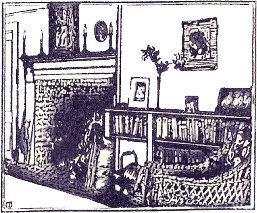Mabel Dodge Luhan built the ‘Big House,’ at 240 Morada Lane in Taos, NM, between 1917 and 1922. It is now a National Historic Landmark. Employing traditional Puebloan construction methods, Tony Luhan oversaw the building of the three-story adobe house for Mabel and married her in 1923. The Big House, which backs onto land owned by the Taos Pueblo, has more than twenty rooms, including the Rainbow Room and a very large (28’x 15′) dining room three steps down from the living room.
In addition to the Big House, Mabel built a number of surrounding guesthouses, including the Pink Adobe, the house Willa Cather and Edith Lewis occupied in 1925 and probably 1926, during Willa’s writing of Death Comes for the Archbishop.
Mabel’s guesthouses and numerous bedrooms in the Big House allowed for a constant stream of guests, many of them famous, including D. H. Lawrence, Georgia O’Keeffe, Ansel Adams, and Leopold Stokowski. Mabel lived in the Big House until sometime around 1954, when she moved into one of her smaller homes. Mabel died in 1962, Tony in 1963.
In Death Comes, book 2 in the series, Willa Cather and Edith Lewis are once again guests of this historic landmark, while they sleuth the macabre discovery of human remains.
From the novel, pages 21–23:
“Lovely. The evening. The day. All of it. Just lovely.” Willa took Edith’s arm to steady their way across the little bridge over the acequia madre that ran just above the wild plum trees lining their walk to the pink adobe. The fragrance of piñon burning in kiva fireplaces in the area invaded their senses and from a distance came the various pitched voices of dogs conversing in the cool night air. Oddly, their voices intensified the silence.
Edith felt compelled to pause, to breathe deeply, to let the sensation of well-being and quiet exhilaration reach all the way to her toes. The unpleasantness at dinner about the uninvestigated deaths of three women finally gave way. Willa called out the constellations, Cassiopeia and the two dippers distinct among the thousands of stars above.
“Taos has to be the most beautiful place on earth,” Willa pressed Edith’s arm closer to her ribs. Edith smiled and nodded in silent agreement.
They had lingered after dinner, Mabel inviting them with Tony into what she called her Rainbow Room, her comfortable library a few steps up from the living room. Rainbow because the room’s ceiling, made up of slender stripped-pine poles called latillas that crisscrossed above thick pine vigas in a herringbone pattern, were variously stained red, blue, and white, the colors of earth and sky, just as they were in the dining room. Like the rest of the house, the Rainbow Room was full of color and art representing a rich mix of cultures and religions from around the world.
Willa and Edith seemed always to be finding new things-sketches and paintings on whitewashed walls of birds, turtles, and other images sacred to the pueblos; an amazing variety of oriental and Navajo rugs, brilliant in their designs; gothic doorways with images sacred to local Catholics, including Our Lady of Guadalupe, carved or painted on the doors; huge portraits and landscapes by the most important artists of the Italian Renaissance interspersed with pieces by Cubists and other contemporary artists and with rustic santos, small wooden carvings and crosses that had adorned homes around Taos for generations depicting the images of saints; the wall of windows in Mabel’s bathroom that Brett and D. H. Lawrence covered with geometric designs to provide Mabel with unwanted modesty; and the large collection of lovely pueblo and Italian vases, pots, and figures, including the large ceramic roosters Mabel distributed along the roofline of the western portal that explained why she named the house Los Gallos. A hodgepodge of everything lovely, Willa called it, just like Mabel herself.
“Yes, yes, a hodgepodge,” Mabel laughed with delight, her voice then slipping into its lower registers, “just like Taos itself. Everything come together as one! That’s as close as anyone has ever come to describing me. Jelliffe, Brill, Jung, none of them caught onto me as well as you. And you have done it in just one word. Hodgepodge.”
Mabel poured each of them an after-dinner coffee and offered them a Lucky Strike from the carton they brought with them from Santa Fe as a gift for Mabel. Tony settled into his large corner chair, as he often did, and began to provide background music for their conversation, drumming and singing traditional pueblo songs. The unfamiliar words and quiet rhythmic sound drew little direct attention but radiated calm and peace. Jamie, the resident tabby, sauntered in to stare at the four of them, each in turn, and finally nestled in Edith’s lap for his evening nap. The women lit their cigarettes, sipped their coffee, and sat for a moment before Mabel continued their conversation with a sly smile, “Hodgepodge, yes, but not always so lovely.”
“Human then,” Willa offered.
“Once again, exactly right.”
 Whale Cove Inn Living Room
Whale Cove Inn Living Room